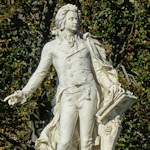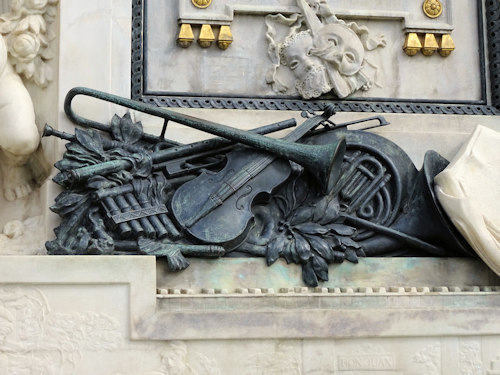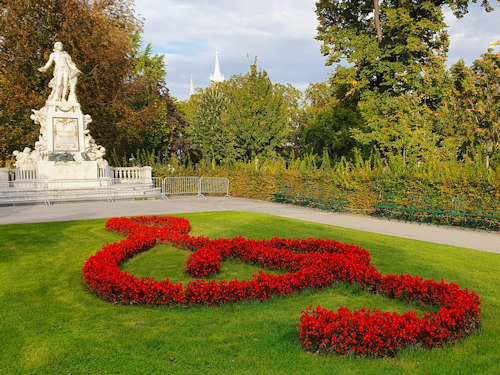
Plaques and a street name hardly suffice when it comes to remembering the greatest composer in history. Which is why Vienna has many monuments dedicated to Mozart. The biggest sits in the central Burggarten park.
- Marble statue of Mozart
- Reliefs depict scenes from his works and childhood
- First unveiled in 1896
- Great photo motif, particularly in the flower season
- Book a concert experience* for Vienna
- See also:
A restless genius

(The Neue Burg palace wing sits behind Mozart)
Karl König (architect) and Viktor Tilgner (sculptor) were the men behind the monument’s design.
Tilgner enjoyed the particular approval of the emperor: Franz Joseph. This inevitably opened a lot of doors in those days.
So the sculptor’s busts of playwrights grace the Burgtheater, and his statues decorate such iconic buildings as the Kunsthistorisches and Naturhistorisches museums, or the Hermesvilla (the summerhouse of the emperor’s wife, Empress Elisabeth).
König is perhaps most famous for the Haus der Industrie building on Schwarzenbergplatz, officially opened in 1911 and still home to the Federation of Austrian Industries.

(Suitably musical reliefs and embellishments)
Sadly, Tilgner died just a few days before the April 21st unveiling of the Mozart monument in 1896. Franz Joseph attended the ceremony and was heard to say (my translation):
It is a source of considerable pain that such a wonderful artist should not be here to witness the completion of his main work.
That unveiling took place in front of the Albertina palace, where the monument gave its name to a nearby café. Unfortunately, the marble Mozart suffered bomb damage during the last days of WWII; following repairs, the statue relocated to the Burggarten park (in 1953).

(The monument in 1896 at its original location on Albertinaplatz square, photographed by Friedrich Strauß; Wien Museum Inv.-Nr. 94600/6/2; excerpt reproduced with permission under the terms of the CC0 licence)
That park itself owes its existence to the deprivations of war, having been built as part of the clear up following the withdrawal of Napoleon’s troops in 1809 (silver linings, etc.).
Mozart’s statue looks out from the top of the monument, one hand turning over the sheet music on the stand next to him.
The composer actually makes a regular perch for pigeons, perhaps allowing them to exact revenge for having a birdcatcher as the star character in The Magic Flute.

(Leopold Mozart and his children Maria Anna and Wolfgang giving a concert in Paris; photo courtesy of the Metropolitan Museum of Art)
The front relief on the installation depicts two scenes from the opera, Don Giovanni. The rear shows Mozart as a young child performing with his father and sister, based on a watercolour by Louis de Carmontelle.
You can see the key part of the original de Carmontelle painting above, taken from a 1764 copy by Jean-Baptiste Joseph Delafosse.
At the right time of year, a perfect bed of flowers spells out a treble clef on the ground in front of the statue. So let us offer a nod of appreciation to the gardeners of the federal Bundesgärten, who manage the park.

(One of your “must-take” photos of any Vienna trip)
How to get to the Mozart monument
The monument is just inside the Burggarten entrance that leads off the great Ring boulevard, so you can see it as you drive (or ride) past. You might also spot in on TV: it appeared, for example, in an episode of the period detective series, Vienna Blood.
Subway: take the U2 line to the Museumsquartier station.
Tram: the Burgring stop is just outside the park entrance and reachable on tram lines 1, 2, 71 and D.
Bus: the 57A bus also stops at Burgring.
Address: Burggarten, 1010 Vienna